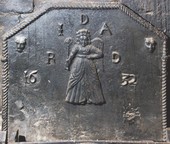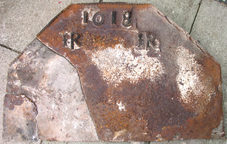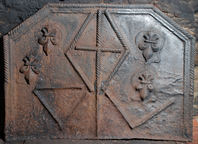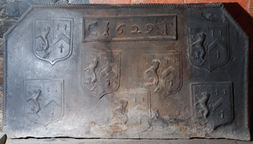-
850
Description: Canted rectangle; elaborate cavetto moulded edging (top and sides); strapwork shield with a demi-flower at each side, between initials (S only visible); arms quarterly of six, 1st Or two chevronels Gules, on a canton of the last a mullet of the first (Pope); 2nd Argent three bars Gules, on a canton ermine a bend of lozenges of the second (Walshe); 3rd Sable three laurel leaves in bend Or between two bendlets Argent (Waller); 4th Azure a chevron between three crosses Moline Argent (Lansdale); 5th Ermine on a bend Gules three lions’ heads erased Or (Weston); 6th Azure a lion rampant Or supporting a cross patée fitchée of the second (Pichingham).
Notes: The excrescence over the third quartering is the result of the iron being poured directly onto the mould. The second initial is known from another casting. The date above the shield has been inserted before casting and differs slightly from another example of the same back.
Copies of this fireback are known.
Inscription: 1625 / S [P]
Arms: Pope (Sackevile Pope (b. 1589) of Hendall, in Buxted, Sussex)
- Decoration tags:
- rectangular with canted top corners (shape)
- complex individual (edging)
- whole carved pattern
- date stamp
- armorial
- text
Manufactured: in 1625 in the Weald area of England.
Current location: not known.
- Attached to series:
- Personal armorial firebacks
- Low relief armorial series
-
812
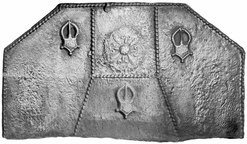 ? x ? mm
? x ? mmDescription: Canted rectangle; twisted rope edging (top and sides); divided by rope lengths into four panels: centre top, square; centre bottom, trapezium; sides, irregular hexagons; buckle stamp repeated three times, in bottom and side panels; top centre panel, circular flower stamp with fleur de lys on each petal.
Notes: The buckle stamps suggest a connection with the Pelham family; illustrated in Butterfield 1916, where it was stated to have been in a house at Herstmonceux, Sussex..
- Decoration tags:
- rectangular with canted top corners (shape)
- rope (edging)
- simple stamps
- carved stamps
- planklines
- heraldic
- objects
Manufactured: in the late-16th century in the Weald area of England.
Current location: not known.
Citation: Butterfield, W. R., 1916, 'Old Wealden Firebacks', The Connoisseur, 46, pp. 197-209.
- Attached to series:
- Pelham family firebacks
- Metalware stamp firebacks
-
1088
Description: Canted rectangular shape; cavetto-moulded edging (top and sides); across the top, double star stamp repeated nine times; below and top centre, date between initials in triad; below date, large hollow fleur-de-lys stamp repeated three times in a line between two triads of stylised fleur-de-lys stamps, with one of the same stamps in each bottom corner; lower centre, woodblock stamp repeated three times in a line.
Notes: The initials 'IIA' in triad probably relate to a couple whose surname initial was 'I' or 'J'; a fireback, dated 1659, with some of the same stamps is at the Dean Heritage Centre, Soudley, Gloucestershire, and another, dated 1667, has been noted at Upper End Farm, Hope Mansell, Herefordshire. Brightwells Auctioneers, Leominster, 27 Jul 2016, lot 694 (£480 inc. grate).
Inscription: IIA [triad] 1668 IIA [triad]
- Decoration tags:
- rectangular with canted top corners (shape)
- cavetto (edging)
- carved stamps
- individual letters
- individual numbers
- heraldic
- text
Manufactured: in 1668 in the Forest of Dean area of England.
Current location: not known.
- Attached to series:
- Hollow fleur Dean series
- Newent area group
- Date & initials firebacks
-
971
Description: Canted rectangle; fillet edging (top and sides); top centre, date between two 'rose' stamps.
Notes: The four nuts are to secure the fireback to two legs.
Inscription: 1658
- Decoration tags:
- rectangular with canted top corners (shape)
- fillet (edging)
- carved stamps
- individual numbers
- text
- plants
Manufactured: in 1658 in England.
Current location: Red Lodge, Park Row, Bristol, England.
Museum number: NX412 (part of the Bristol Museums, Galleries and Archives museum group)
- Attached to series:
- Date only firebacks
-
973
Description: Canted rectangle; fillet edging (top and sides); date to full width across centre of plate.
Notes: Bold, evenly-spaced numerals.
Inscription: 1688
- Decoration tags:
- rectangular with canted top corners (shape)
- fillet (edging)
- carved stamps
- individual numbers
- text
Manufactured: in 1688 in England.
Current location: Red Lodge, Park Row, Bristol, England.
Museum number: NX1064 (part of the Bristol Museums, Galleries and Archives museum group)
- Attached to series:
- Date only firebacks
- 1680s Canted series
-
1000
Description: Canted rectangle; stepped fillet edging (top and sides); straight twisted rope lengths parallel to top and parallel to each side, forming inner rectangle with rope quadrants across top corners; side compartments: line of 12 beads along top inside rope line, 3 semi-circular at corners, with a single bead in each corner quadrant, and 8 down each side; top centre, date with single bead above; cross with a cross stamp repeated 10 times to right of date and 9 time to left, one in each corner, and 13 down the left side and 12 down the right.
Notes: The quadrant arc and use of repeated beads suggests a common source with other firebacks of the same period.
Inscription: 1686
- Decoration tags:
- rectangular with canted top corners (shape)
- stepped fillet (edging)
- carved stamps
- individual numbers
- text
- objects
Manufactured: in 1686 in the Forest of Dean area of England.
Current location: Ashmolean Museum Broadway, 65 High Street, Broadway, Worcestershire, England.
(part of the Ashmolean Museum museum group)
- Attached to series:
- Newent area group
- Square cross Dean series 2
-
1027
Description: Canted rectangle; inset twisted rope edging (top and sides); stamp formed of a statuette of an standing angel with left hand at the waist, and holding a sceptre in the right hand; date split either side of angel; initials 'RD' split above date; initials 'IDA' in triad above angel; small face stamp in each top corner.
Notes: The identity of those to whom the initials refer is not known; the use of the angel statuette is a rare inclusion of a religious motif on an English fireback. A variant of this fireback is at Flaxley Abbey, Gloucestershire (no. 293).
Inscription: IDA [triad] / R D / 16 32
- Decoration tags:
- rectangular with canted top corners (shape)
- rope (edging)
- carved stamps
- individual letters
- individual numbers
- text
- humans
Manufactured: in 1632 in the Forest of Dean area of England.
Current location: The Lygon Arms, High Street, Broadway, Worcestershire, England.
- Attached to series:
- Figurine firebacks
- Angel series
- Date & initials firebacks
-
811
Description: Canted rectangle; twisted rope edging (top and canting only); centre top, date (written as 1018); below to left and right, initials.
Notes: It has been suggested that the initials IR relate to King James I but the lack of any other royal decoration makes this unlikely.
Inscription: 1618 / IR IR
- Decoration tags:
- rectangular with canted top corners (shape)
- rope (edging)
- individual letters
- individual numbers
- text
Manufactured: in 1618 possibly in the Shropshire area of England.
Current location: 50, Church Street, Broseley, Shropshire, England.
- Attached to series:
- Date & initials firebacks
-
826
Description: Canted rectangular shape with moulded edging (top and sides) overlain by a length of twisted rope repeated six times; central vertical line formed of twisted rope, crossed with rope upper centre, with rope laid in a diamond pattern around the cross; lower centre, two irregular v-shapes formed of rope, one on each side of the vertical; shield shaped stamp with a fleur de lys repeated twice each side, upper left and right.
Notes: The twin V arrangement may have apotropaic significance and the cross above them having a Christian symbolism; the base board appears to have had a moulded edge, with rope lengths applied over part of the moulding after the board had been pressed into the casting bed; a sketch of this fireback was made by J. Starkie Gardner c.1891 and is in his collection at the Victoria and Albert Museum, Archive of Art and Design (AAD/2014/8).
- Decoration tags:
- rectangular with canted top corners (shape)
- rope over moulding (edging)
- simple stamps
- carved stamps
- heraldic
- apotropaic
- objects
Manufactured: in the late-16th century in the Weald area of England.
Current location: in private hands, Burwash, East Sussex, England.
- Attached to series:
- Miscellaneous stamp firebacks
- Rope design firebacks
-
30
Description: Rectangular, with canted top corners; twisted rope edging on top and sides; cavetto-moulded-edged rectangle top centre, enclosing date between initials; seven shields of Ayloffe impaling Sulyard; Ayloffe: sable, a lion rampant Or, collared gules, between three crosses formy of the second; Sulyard: argent, a chevron gules between three pheons inverted sable.
Notes: William Ayloffe (c.1535-1584) of Bretons, Hornchurch, Essex, Justice of the Court of Queen’s Bench, married (c1560) Jane, dau. of Sir Eustace Sulyard, of Runwell, Essex. A large number of variants use the same shields. The possibility that 'CT' was the founder Charles Tyler (d.1629/30) is reinforced by the fact that Poundsford Farm, Burwash, was owned by his grandson, also Charles, and subsequently by the latter's widow, Mary. The back was first noted at Poundsford in 1869.
Inscription: C 1629 T
Arms: Ayloffe impaling Sulyard (William Ayloffe of Bretons, Hornchurch)
- Decoration tags:
- rectangular with canted top corners (shape)
- rope (edging)
- carved stamps
- individual letters
- individual numbers
- planklines
- armorial
- text
Manufactured: in 1629 possibly at Hawkhurst Furnace in the Weald area of England.
Current location: Poundsford Farm, Burwash, East Sussex, England.
Citation: Gardner, J. S., 1898, 'Iron Casting in the Weald', Archaeologia, 56, 1, pp. 133-164.
Citation: Trower, C. F., 1869, 'Burwash', Sussex Archaeological Collections, 21, p. 113.
- Attached to series:
- Ayloffe series
- Personal armorial firebacks





